
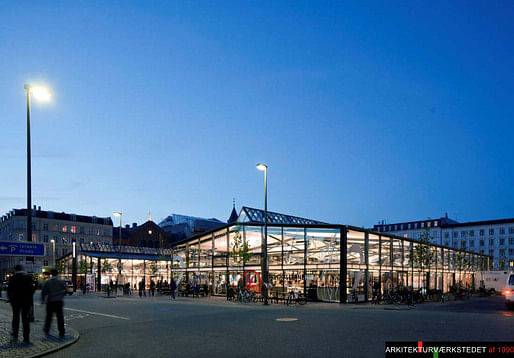 The new Torvehallerne, Copenahagen. Photo: Arkitekturvaerkstedet
The new Torvehallerne, Copenahagen. Photo: Arkitekturvaerkstedet
Copenhagen’s IsraelsPlads was once home to a vibrant outdoor market, which took place daily in the plaza until the mid-20th century, when a wholesale market was established in Valby, on the outskirts of the city. After decades of neglect, the site at IsraelsPlads has been revitalized as a public food market, conceived and designed by Danish architect Hans Peter Hagens. Torvehallerne opened in 2011, after 14 years of political negotiations, design and construction processes, and is almost instantly one of the busiest public spaces in a city full of them.
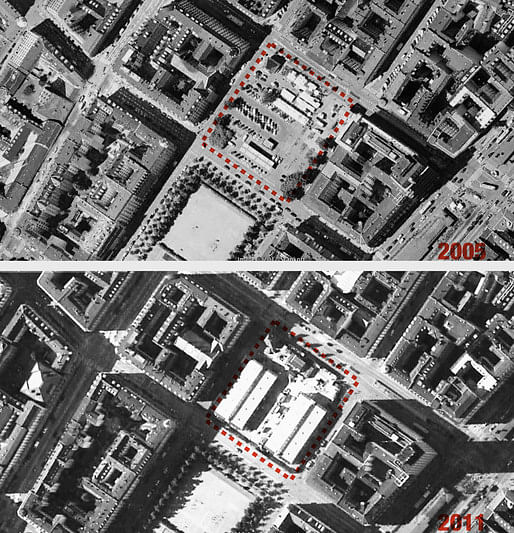 The market site, 2005 and 2011. Image by author
The market site, 2005 and 2011. Image by author
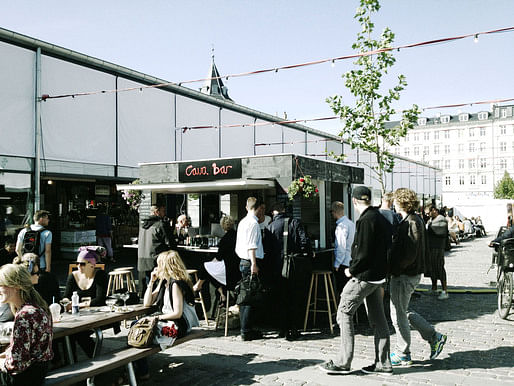 Torvehallerne courtyard, public open space between two market halls. Photo by author
Torvehallerne courtyard, public open space between two market halls. Photo by author
But does it function as a real food market? Unless you’re pulling in a lot more than I did as an intern when I lived in Copenhagen, you might not be shopping there. Then again, if a market should reflect its place, you might expect something this trendy in the Danish capital, where even your average waitress makes a living wage and shops at Henrik Vibskov. While Torvehallerne appears to be an overwhelming success as an active ‘public’ space, one might question what kind of ‘public’ can afford to shop for groceries in a place where you could spend $8 for a fruit smoothie? I met with Hans Peter in his office on Christianshavn to talk about the project.
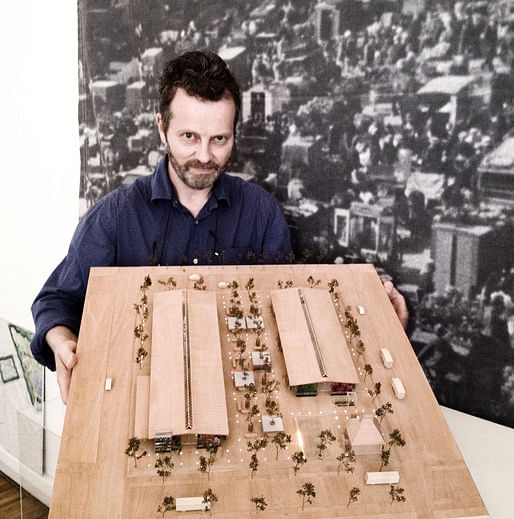 Architect Hans Peter Hagens with a model of Torvehallerne. Photo by author
Architect Hans Peter Hagens with a model of Torvehallerne. Photo by author
Check out the excerpts below:
A market is a complex system of relationships between past and present cultural histories, economies, technologies, etc.
HPH: I was living in the neighborhood near Israelsplads for 20 years, and when I started this project 14 years ago there was a gas station and a lot of parking lots. So I looked up these photos and found out that in Copenhagen we had this really proud market tradition, which was running like that from 1889 to 1958. There was a completely open market in the plaza. And it was a huge meeting point. But they also had the wholesale market, and in 1958 they moved the wholesale market to Valby, just outside Copenhagen.
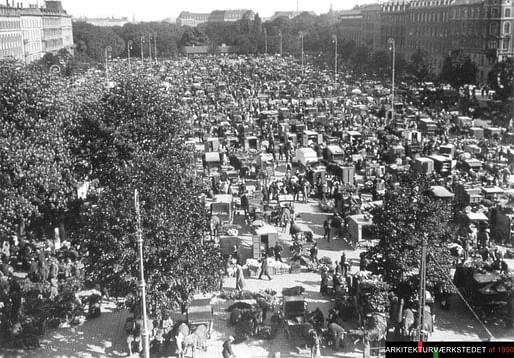 Historic photo of IsraelsPlads market.
Historic photo of IsraelsPlads market.
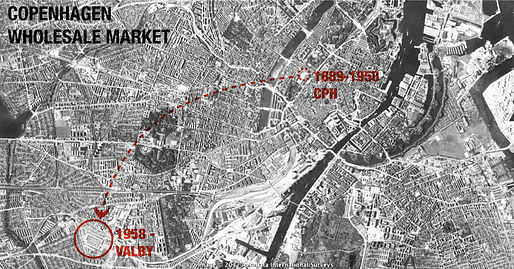 Map of Copenhagen and Valby. Image by author
Map of Copenhagen and Valby. Image by author
Ownership
HPH: Previously the municipality owned the market site, but they were running low on money and they sold it to the state. So today it is the State that owns the land, but the municipality has the right to run it. So the municipality rented the whole area to a private investor, and it is that investor who is running the market. First we had to convince the municipality that the market was the right use of space, and we made drawings that they bid out to investors to carry out the project.
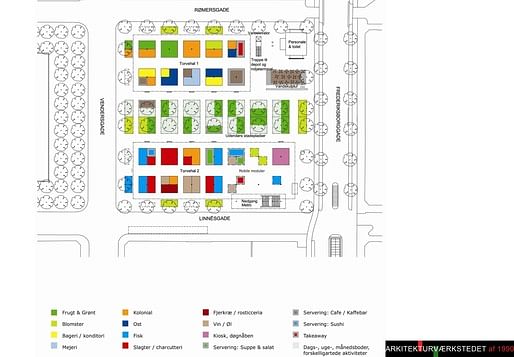
Plan of market stall functions. Image by Arkitekturvaerkstedet
Design
HPH: The market constructions themselves we tried to make very simple, so you can see how they are connected. I wanted to make this building very simple, so that the food is the party.

Interior view of one market hall. The structure of the vendor stalls is connected to the structure of the roof of the hall. The resulting form is an elegant triangulated system of steel tubes supporting a slightly pitched roof with a linear skylight at the ridge. Photo by author.
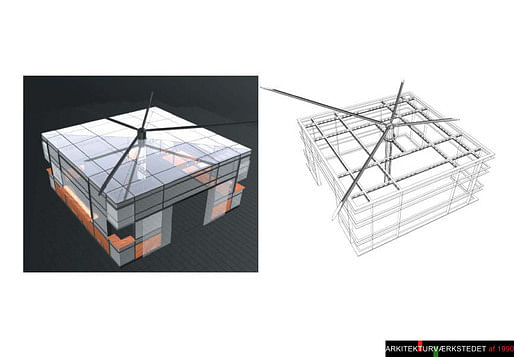
Axon views of the square stall structures, illustrating how the central column is connected to the roof beams. The square stalls can be divided to accommodate up to 4 separate vendors, or a single vendor can take the whole space. Image by Arkitekturvaerkstedet

Each stall is designed independently, so the whole projects works as an interesting system of difference and repetition. The module of the stall gives way to the difference of material and form, within a basic framework defined by Hans Peter Hagens. Photo by author.
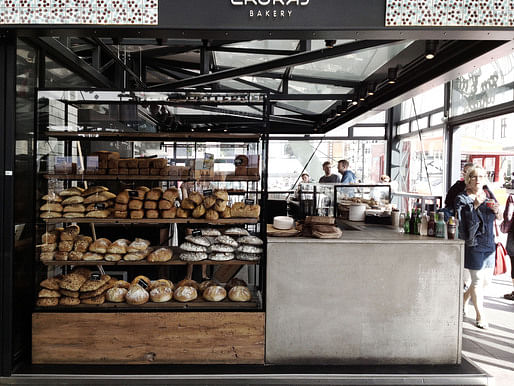
A hip baker. Photo by author.
HPH: One really important aspect is the connection between the market halls and the plaza. We have planted out 37 plane trees on the same grid as the steel columns of the market, so it will make outside and inside more connected. And then we intended to have outdoor stalls around these trees.
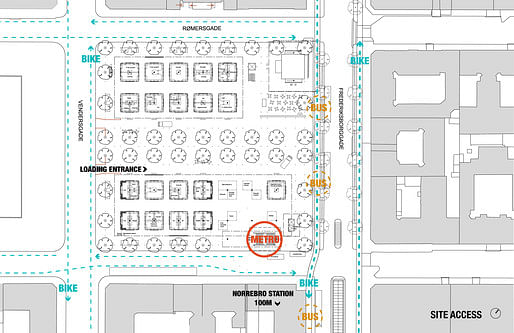
Site Access. Image by author, with background plan from Arkitekturvaerkstedet

Indoor/outdoor connections. mage by author, with background plan from Arkitekturvaerkstedet
 Interior view near an access point. Photo by author.
Interior view near an access point. Photo by author.
HPH: The border between inside and outside is very fluid. There are no steps. You need to have the feeling that the market is part of the street. That it’s completely public…
The market building in combination with the outdoor plaza is very important. That’s another reason why we are fighting a little here in Copenhagen. The developer doesn’t believe in the outdoor market. But it’s the outdoor market that would allow there to be more cheap produce, because it’s less expensive for the vendors. You could attract all kinds of customers. … Because if it’s too expensive then you’re going to run into problems.
 Exterior view from the courtyard. The exterior vendors are expected to bring a more diverse clientele to the market, because they will be selling more whole foods and fresh fruits and vegetables at lower prices. Unfortunately, the plaza is still mostly empty of vendors....Photo by author.
Exterior view from the courtyard. The exterior vendors are expected to bring a more diverse clientele to the market, because they will be selling more whole foods and fresh fruits and vegetables at lower prices. Unfortunately, the plaza is still mostly empty of vendors....Photo by author.
HPH: If you have a range of prices, you invite in everybody, which is very important.
Often when you have a market, it makes a lot of new restaurants and small shops come up into the neighborhood.
Drama
HPH: The client is sometimes changing the project without asking us. So right now I’m quite angry because they put up a lot of these white sheets on the facades, and I find it so ugly. Because you know it’s very important to have an open structure, so you can look through the market and get an impression of all the food.

The glass halls are currently covered in white fabric screens to prevent solar gain, which has been a major point of contention between the client and architect.
HPH: We made many different solutions for the solar screens, but it’s done in a very ugly way. So right now we are fighting about that. We want them to change it. I’m so embarrassed, because people believe that I made it. It was designed to be even more open before. In many good markets in France and Spain and so on, you have nearly 50% indoor market functions and 50% outdoor. We want a huge outdoor market between the two market halls, but right now it’s much too little. In Denmark we could invite in stall-keepers from all parts of Denmark, from Bornholm, from Jutland, and all the small islands. It would be a good way to show the different products of the country.
Research methods
HPH: I’ve been measuring up markets in various places, and talking to the vendors to ask them how they would make the market if they could design it themselves. And then we took those recommendations and tried to apply them to this market. One of the main differences between a market and a supermarket is that the different stalls have to be very small. The range of stall sizes tends to be anywhere from 10-60 square meters. In Copenhagen, it’s 12, 25, 37, and maximum 50, so there a number of different scales of stalls, depending on what the vendors are selling.

Photos from a market in Helsinki, by Hans Peter Hagens.
HPH: In Roman times, they combined the market with the theater. Because you had many people in both facilities, so why not bring them together? It’s quite funny.
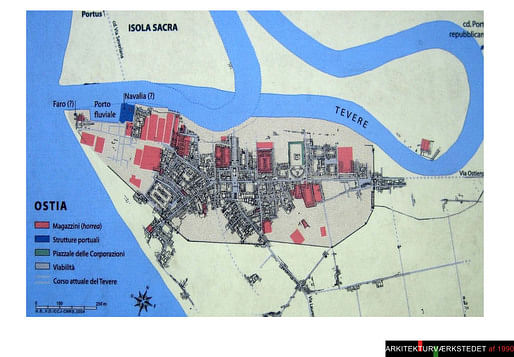
Map of historic Ostia, the port city near Rome. Image from Arkitekturvaerkstedet

Plan of the theater and market, adjacent structures in Roman times at Ostia. Image from Arkitekturvaerkstedet
Torvehallerne is a destination market at the scale of a neighborhood market. It is an interesting case study for my project at the architectural and urban design scale (where it is mostly successful, minus the white shades), but unfortunately it is still removed (like many farmers markets in the United States), from the large-scale system of distribution. One market can't solve a systemic problem, but it's a great 'scene' to hang out (and be seen) if you've got money to spend in Copenhagen...
I am a graduate M.Arch/MLA student at UC Berkeley, and grateful recipient of the 2011-2012 John K. Branner Fellowship, an annual traveling fellowship awarded by the UC Berkeley Department of Architecture. I will spend the 2012 calendar year visiting public food markets in major cities on 5 continents to research the relationship between markets and the infrastructure of food systems, focusing on the cultural and urban design implications of local economies. This blog will follow my journey...



3 Comments
LA needs this
Great story and impressive architectural/cultural research by architect Hagens. Also familiar disappointment by owners's sunshade, which probably should have been addressed in the original design (awnings shading glass?). There are many attempts at public markets but only a few successes.
Thanks for the comments. It's true that the architecture of this project is no way avant garde, or 'research-oriented' from a construction technology perspective, but it is unique as a successful market from (relative) scratch. The lessons for me here are not so much in the business model, but in the way it manipulates the temporality of market functions - the structure implies lightness (compared to more massive market halls), indoor and outdoor activities operate at different time (and economic) scales, the double hall allows the plaza to be used as part of the market rather than just as an auxiliary space, etc. Hans Peter's research is applied strategically here, not merely mimicked.
That said, I agree that markets (this one included) tend to be architecturally.... well, safe. My research is attempting to connect economics, food systems, and infrastructure with design, and I am interested in the Architectural opportunities that markets present. While they typically aren't as exciting or experimental as (generally unprogrammed) 'installations', there's no reason why they couldn't be.
Please let me know if you have any recommendations for further site visits, readings, or people to meet. Thanks!
Block this user
Are you sure you want to block this user and hide all related comments throughout the site?
Archinect
This is your first comment on Archinect. Your comment will be visible once approved.